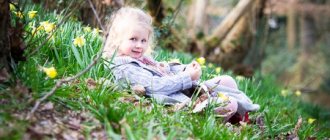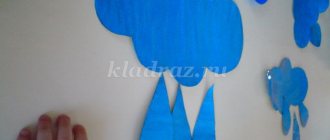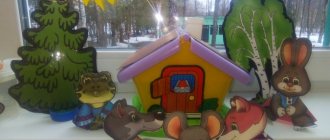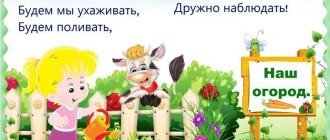Research work in the preparatory group for Cosmonautics Day
Research work with a child 6 - 7 years old “A Star Called the Sun”
Description : This work is intended for children of older preschool age. The research is carried out as part of a project activity or a week dedicated to Cosmonautics Day.
1. Give an idea about the Sun and the Solar System 2. Develop the ability to research, reason, tell others about your research 3. Cultivate interest in research activities
1 slide
I never thought about what kind of sun it is.
I knew that it warms, shines and is very far from us. But one day, in kindergarten, we were told about the solar system. Slide 2 I was very surprised to learn that our planet revolves around the Sun. I was very interested in this topic and decided to study it. I wanted to know what the Sun, the solar system, is? Why is the Sun called the source of life on earth? And, in general, why does our planet need it? To learn more about the Sun and the solar system, I decided to read about it in the encyclopedia with my teacher. 3 slide From it I learned that the sun is a star, and the closest to our planet is a huge flaming ball of gas. The warmth and light coming from it warm and illuminate the earth and support life on it. Slide 4 Planets revolve around the Sun, one of which we live on. In addition to planets, satellites, comets and asteroids revolve around the sun. This is called the solar system. Our planet is called Earth. Slide 5
In kindergarten, the guys and I made a model of the solar system, now not only I know that our planet revolves around the sun, the guys in our group also know about it.
Slide 6
I wondered how on earth day turns into night and I asked about this in kindergarten.
It turns out that the Earth rotates not only around the Sun, but also around its own axis. We conducted the following experiment: we placed the globe in a dark room. They shined a flashlight on one side of it and spun the globe. This is how we learned that when it is day for us, it is night on the opposite side of the Earth and vice versa. Slide 7
I also noticed that the sun rises in the east every morning, and sets in the west in the evening.
One sunny morning I decided to check how the sun changes its location in the sky throughout the day. I took a pencil and marked where the light from the window was. And so I noted every hour until the light from the window disappeared. I realized that when it rises from the east, it brings light and warmth, and when it sets to the west, it becomes dark and cool. Slide 8
Why do they say that without the sun there is no life on Earth?
I decided to find out this too. I conducted the following experiment: I simultaneously planted marigold seeds in two different cups. I placed one glass in a well-lit room, and the other in a dark closet. The plant, which was grown in a well-lit area, grew strong, green and looked beautiful. And the plant that I hid in the closet took a very long time to germinate, it was small and faded. Soon it died. Only in the light can plants grow well, but in the dark they die. I talked about this in kindergarten. Elena Valerievna said that a plant grown under the rays of the sun releases oxygen, which we breathe, but a plant that stands in the dark does not. Therefore, humans also need the sun. Without him it would be dark and cold. Slide 9
Thanks to my research, I learned: - The sun is a star;
— Our solar system consists of planets, their satellites, asteroids and comets revolving around the Sun; - When it is day on one side of the Earth, it is night on the opposite side; — The sun helps plants grow. Slide 10
The most important thing I learned is that the Sun is the most important source of life on Earth.
Presentation on the topic: A star called the Sun. Research work in the preparatory group for Cosmonautics Day
We recommend watching:
Summary of direct educational activities in the senior group of preschool educational institutions. Summary of correctional and developmental classes in the preparatory group. Topic: “Space travel Summary of a lesson in the preparatory group on familiarization with space for Cosmonautics Day Summary of a physical education lesson in the senior group on the topic: Space
Similar articles:
Conversation for children of the preparatory group “Stars and Constellations”
Conversation about space in the senior group
A fairy tale about space for preschool children 5-7 years old
Project "Sun" for children 4-6 years old
Relevance:
Summer is a time of warm, sunny days and a favorable time for observing the sun, conducting experiments and experiments with the sun's rays. The Russian people have composed many proverbs and sayings about the sun.
He was compared to his mother: “The sun is like a dear mother and will warm and caress.” It largely determined the way of life of the Russian people: “The sun rises, so the day comes.” The harvest depended on the number of sunny days. “When the sun warms up, everything will be in time.”
Research “What is the sun for?” is designed to help create a positive emotional mood among preschoolers in the summer and unite the children's team.
Objective of the project:
Creating conditions for the development of children's cognitive activity when studying a natural object - the sun.
Tasks:
Educational:
- Contribute to the active acquisition of elementary ideas about the nature of the sun, its influence on the world around us.
- Introduce the rules of safe behavior during the hot season.
- Strengthen the skills of cutting, gluing, drawing with pencils.
- To form the cognitive activity of children when conducting experiments and observations.
- Enrich children's vocabulary on this topic.
Educational:
- Promote the development of cognitive processes and creative abilities of children.
- Encourage children to engage in productive activities on the topic of the project.
- Develop children's coherent speech and fine motor skills.
Educational:
- Cultivate independence, accuracy, perseverance.
- Learn to work in a team, coordinate your actions with each other.
Fundamental question:
What is the sun for?
Specific questions and research topics:
- Why does the sun shine?
- Topic of research: Visiting the sun. What happens if the sun stops shining?
- Research topic: The sun is our friend. When can the sun be dangerous?
- Research topic: Be healthy!
Motivation:
Invite the children to guess the riddle about the sun.
It has risen into the sky, and looks towards us through the window. It gives us light and warmth. Always let it shine... (Sun)
Ask what children want to know about the sun.
Integrated educational areas:
- Cognitive development.
- Speech development.
- Social and communicative development.
- Artistic and aesthetic development.
Forms and methods of work:
- direct educational activities;
- conducting experiments and experiments with solar rays;
- viewing illustrations;
- finger and outdoor games, physical education sessions;
- listening and learning poems, riddles and songs about the sun;
- study of proverbs and sayings about the sun;
- consultations and information corners for parents.
Final event:
- Exhibition of creative works “Radiant Sun”, made by children in kindergarten and at home, together with their parents.
- Watch the video “What is the sun for?”
Expected Result:
Children talk (or answer questions) about the sun and its influence on the world around them. Know the rules of safe behavior in the hot season. They independently conduct experiments and experiments with the sun. They play finger and outdoor games related to the sun. Passionate about creating drawings and sun crafts. They sing a song about the sun and read poetry.
Educational and methodological package with applications:
- Business card of the project.
- GCD notes.
- Card index of finger and outdoor games, physical education minutes.
- Card index of poems and riddles about the sun.
- Card index of proverbs about the sun.
- Card index of experiences and experiments with the sun.
- Information corners for parents.
- Photo library with songs about the sun.
- Illustrative materials.
Hypothesis: The sun is needed to shine and warm. It shines because there is hot lava. If the sun stops shining, it will be dark and cold. The sun can be dangerous. If you fly close to it, you can burn. Chocolate may melt in the sun.
Conclusions:
The Sun is the star closest to us. It looks like a huge fireball. The sun gives light and warmth. It heats the earth, water in rivers, seas and oceans. The speed of sunlight is very fast. Just 8 seconds. At that time, if a rocket flew to the sun, it would take 8 months, and an airplane 20 years. If the sun stops shining, there will be no life on Earth, it will turn into ice. People, animals and plants will die. If a person lives for a long time without sunlight, he may get sick. The sun can be dangerous. If you look at the sun for too long, you can go blind. If you sunbathe for a long time, you can burn and it will hurt. In hot weather, you need to drink more water, wear a Panama hat and try not to go outside in the heat. It is better to sunbathe in the morning and evening.
Results of the work carried out:
Preschoolers are conscious about their health and explain the rules for staying in the sun. They talk about the sun as a natural object, about its influence on the surrounding life. They share their impressions of the experiments carried out. They enthusiastically play outdoor games “Sun-bucket” and “Sunny bunnies”. They sing a song about the sun and read poetry. They draw and sculpt the sun themselves.
Future prospects:
Continue studying the sun as the center of the solar system. Enrich the exhibition “Radiant Sun”
Project "Sun"
Irina Garmaeva
Project "Sun"
«Sun»
Problem. At the age of 2-3 years, children know little about natural phenomena, including the natural object - the sun . Moreover, in conversations with children, some of them found it difficult to answer questions about what color or shape the sun . the sun were also used little .
The relevance of the development and implementation of a pedagogical project .
The topic was chosen in April. And it was developed for implementation closer to the “Day of the Sun ”
(May 3 –
“Day
of the Sun ” ).
At this time, the sun begins to shine more often, brighter, and becomes warmer. Of course, the children also noticed this. At this age (2-3 years),
children develop a sensory concept
(shape, color, size)
.
I also wanted to enrich children’s knowledge about a natural object - the sun , to show the influence of the sun on nature .
In this regard, such a topic was identified. Project goal : to stimulate curiosity, develop the ability to observe natural changes (it has become warmer, snow is melting, puddles have appeared)
;formation of an active vocabulary in children through the organization of different types of activities: gaming
(primarily)
;
cognitive (observations, artistic expression)
; artistic, aesthetic, productive.
Tasks:
1. Give children basic ideas about a natural object - the sun , its influence on the world around them.
2. To form children’s cognitive activity when conducting observations.
3. Cultivate interest and love for nature, kindness and responsiveness to each other and to others
4. Reinforce the concept of “yellow”
,
“round”
,
“looks like”
,
“doesn’t look like”
.
5. Develop skills in working with a brush, paints, and plasticine.
6. Continue to teach children to listen to fairy tales, poems, and nursery rhymes.
Hypothesis: I assume that during the project , children will become familiar with the influence of the sun on nature , this will contribute to the development of children’s cognitive abilities and observation skills.
Project type : Cognitive and creative.
Participants: Teachers - group teacher Irina Vladimirovna, children 2-3 years old, parents.
Duration: 6 weeks (short-term)
Expected Result:
- development of observation skills in children (they recognize and name the sun in books , in pictures)
;
- enrichment of children’s active and passive vocabulary through the words: “bright”
,
“light”
,
“warm”
,
“shines”
,
“smiles”
,
“warms”
,
“
sun ” ,
“radiant”
, etc.
- recognize and name the color yellow;
Preparatory stage: 2 weeks
1. Conversations with children to identify children’s knowledge about the sun .
2. Preparation of poems, nursery rhymes, riddles, games, using “ sun ”
, illustration material.
3. Preparation of attributes for games, GCD.
Main stage: 2 weeks
1. Observation of changes in nature associated with the sun . Thematic walk “Watching the sun ”
.
2. Outdoor games “ Sunshine and Rain ”
,
"
Sunny " ,
"
Sunny Bunnies " .
3. Reading and memorizing poems about the sun .
4. Complex of morning exercises “Radiant Sun ”
.
5. Carrying out drawing and modeling on the theme “ Sun ”
.
"
Sunny Bunnies " ,
"Rain"
.
6. Observing the sunrise and sunset ( according to illustrations, with the help of parents at home)
.
7. Didactic game “Droplets and Clouds”
and
“Help me find the rays
.
8. Finger games “ Sunny ”
,
"Clouds"
.
9. Listening to songs “Tender Sun ”
,
“Cloud and
Sun ” ,
“Evil Cloud”
,
“I
’m Lying in the Sun ” .
10. Reading the fairy tale “
Sun and Rain ” (T. A. Shorygina)
.
Final stage: 2 weeks
Summing up the project .
Design of a wall newspaper for parents based on the results of the project .
Conclusion:
I wanted to give children a basic understanding of the sun and its influence on nature. And also involve each participant in an active, educational and creative process.
During the implementation of this project, children watched with interest the activity of the sun and drew conclusions about its influence on nature. This contributed to the development of children's cognitive abilities, observation and the development of creative imagination.
During the outdoor games “ Sunshine and Rain ”
,
"
Sunny Bunnies " children practiced consciously and meaningfully performing actions with the text.
On directly organized activities:
- by modeling, they reinforced the ability to roll out plasticine between the palms.
— drawing lessons reinforced the ability to use a brush and paint correctly. Continue to master the ability to navigate on a sheet of paper orientate on a sheet Teach children to draw using unconventional methods (drawing with palms)
.Consolidate knowledge about color: yellow.
We learned several poems for finger games, which contributed to the development of fine motor skills, children’s speech and memory.
Listening to cheerful songs during routine moments evoked positive emotions.
Performing morning exercises “Radiant Sun ”
contributed to physical development and awakening of the body for normal life.
After listening to T. A. Shorygina’s fairy tale “ Sun and Rain ”
The children learned what is better - rain or
sun .
Thus, the tasks and goals of the project were fulfilled :
— children learned about the features of the sun and its role .
- mastered the ability to draw in different ways.
- enjoyment of working in a team.
— children’s cognitive activity is formed when conducting observations
— vocabulary is enriched.
Bibliography.
1.. Eliseeva, L. N. Reader for little ones / L. N. Eliseeva. – M.: Education, 1982.
2. Visual activities in kindergarten / Ed. Komarova T. S. - M.: Mozaika-Sintez, 2010
3. Visual activities in kindergarten: Lesson plans. Practical guide for teachers of preschool institutions. – M.: Mozaika-Sintez, 2003
4.Drawing with preschool children: Non-traditional techniques, planning, lesson notes / Ed. R. G. Kazakova - M.: Sphere shopping center, 2005.-128 p.
5. Educational games for children 2 – 7 years old / author. -composition E. N. Mikhina. –Volgograd: — 2013
6. Savelyeva E. A. Finger and gesture games in verse for preschoolers. – St. Petersburg: 2010
7. Yanushko E. A. Modeling with young children (1-3 years)
. Methodological manual for educators and parents. – M.: Mosaic-synthesis, 2007
8. https://detsadd.narod.ru/index_2_7_173.html Summary of joint educational activities with children in drawing




